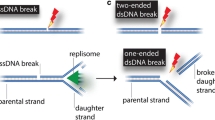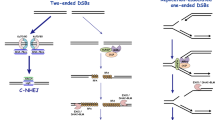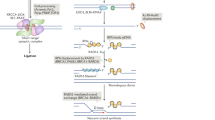Abstract.
DNA double-strand breaks (DSBs) arise in cells from endogenous and exogenous attacks on the DNA backbone, but also as a direct consequence of replication failures. Proper repair of all these DSBs is essential for genome stability. Repair of broken chromosomes is a challenge for dividing cells that need to distribute equal genetic information to daughter cells. Consequently, eukaryotic organisms have evolved multi-potent and efficient mechanisms to repair DSBs that are primarily divided into two types of pathways: nonhomologous end joining (NHEJ) and homologous recombination (HR). Here we briefly describe how eukaryotic cells sense DSBs and trigger cell cycle arrest to allow repair, and we review the mechanisms of both NHEJ and HR pathways and the choice between them. (Part of a Multi-author Review)
Similar content being viewed by others
Author information
Authors and Affiliations
Corresponding author
Rights and permissions
About this article
Cite this article
Pardo, B., Gómez-González, B. & Aguilera, A. DNA Repair in Mammalian Cells. Cell. Mol. Life Sci. 66, 1039–1056 (2009). https://doi.org/10.1007/s00018-009-8740-3
Published:
Issue Date:
DOI: https://doi.org/10.1007/s00018-009-8740-3




